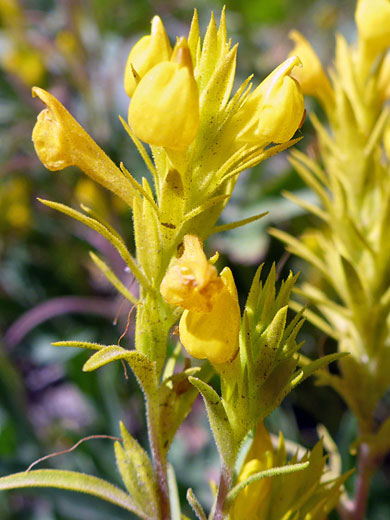Common name:
Yellow owl clover
Family:
Scientific name:
Orthocarpus luteus
Main flower color:
Range:
The Rocky Mountain states, all states to the west, and the northern Great Plains
Height:
Between 4 and 16 inches
Habitat:
Meadows, sagebrush, moist hillsides; 4,000 to 10,000 feet
Leaves:
Alternate, narrow, linear, up to 1.5 inches long; those at the top are divided into 3 lobes
Season:
July to August
Like the related castilleja (paintbriush) species, the leaves of orthocarpus luteus are gradually replaced by floral bracts towards the top of the stem. Basal and lower stem leaves are entire, while those above are deeply divided into three narrow lobes. Stems and leaves are colored yellowish green, often purplish later in the season. They have a light covering of short, glandular hairs, mixed with longer, non-glandular hairs. Stems are usually unbranched.
The inflorescence is a narrow, elongated cluster extending up to 7 inches at the top of the stem. Each flower is subtended by a bract, divided into three (less often five) lobes; a pair of narrowly triangular side lobes and a larger, lance-shaped central lobe. The yellow flower has a tubular corolla, half an inch long, which opens to two lips. The upper lip is straight, narrow and has a small, inwards-curving beak, while the lower lip is larger, expanded downwards to form a pouch. Corolla and bracts are glandular hairy.
The inflorescence is a narrow, elongated cluster extending up to 7 inches at the top of the stem. Each flower is subtended by a bract, divided into three (less often five) lobes; a pair of narrowly triangular side lobes and a larger, lance-shaped central lobe. The yellow flower has a tubular corolla, half an inch long, which opens to two lips. The upper lip is straight, narrow and has a small, inwards-curving beak, while the lower lip is larger, expanded downwards to form a pouch. Corolla and bracts are glandular hairy.
All Contents © Copyright The American Southwest | Comments and Questions | Contribute | Site Map



